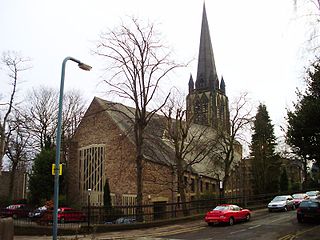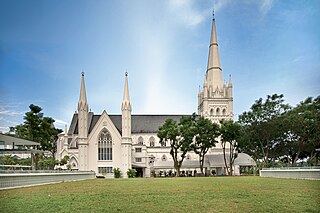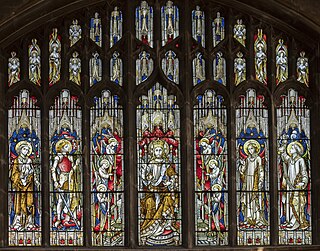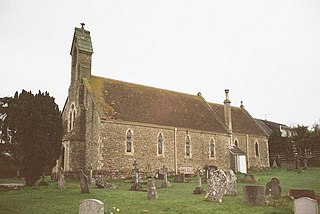
The Cathedral Church of St Peter and St Wilfrid, commonly known as Ripon Cathedral, and until 1836 known as Ripon Minster, is a cathedral in Ripon, North Yorkshire, England. Founded as a monastery by monks of the Irish tradition in the 660s, it was refounded as a Benedictine monastery by St Wilfrid in 672. The church became collegiate in the tenth century, and acted as a mother church within the large Diocese of York for the remainder of the Middle Ages. The present church is the fourth, and was built between the 13th and 16th centuries. In 1836 the church became the cathedral for the Diocese of Ripon. In 2014 the Diocese was incorporated into the new Diocese of Leeds, and the church became one of three co-equal cathedrals of the Bishop of Leeds.

Church of St Mark is a Church of England parish church in the Sheffield suburb of Broomhill, in the United Kingdom.

Saint Andrew's Cathedral is an Anglican cathedral in Singapore. It is located near City Hall, Downtown Core, within the Central Area in Singapore's central business district. It is the main cathedral church of the Anglican Diocese of Singapore and serves as the mother church of 27 parishes and more than 55 congregations. The church has existed on the site since 1836, although the current building was constructed in 1856–1861. The logo of the cathedral is the St Andrew's Cross.

Hardman & Co., otherwise John Hardman Trading Co., Ltd., founded 1838, began manufacturing stained glass in 1844 and became one of the world's leading manufacturers of stained glass and ecclesiastical fittings. The business closed in 2008.

St Etheldreda's Church is a Roman Catholic church in Ely Place, off Charterhouse Street in Holborn, London. The building is one of only two surviving in London from the reign of Edward I, and dates from between 1250 and 1290. It is dedicated to Æthelthryth, or Etheldreda, the Anglo-Saxon saint who founded the monastery at Ely in 673. It was the chapel of the London residence of the Bishops of Ely.

The Church and Friary of St Francis, known locally as Gorton Monastery, is a Grade II* listed former Franciscan friary in Gorton, Manchester, England. It was designed by the noted Victorian architect Edward Welby Pugin and built 1866–1872. Gorton Monastery is a noted example of Gothic Revival architecture.
Daniel Cottier (1838–1891) was a British artist and designer born in Anderston, Glasgow, Scotland. His work was said to be influenced by the writing of John Ruskin, the paintings of the Dante Gabriel Rossetti and the work of William Morris. He painted allegorical figures in the Pre-Raphaelite style of Rossetti and Sir Edward Burne-Jones. Cottier is considered to be an important influence on Louis Comfort Tiffany and also is credited with introducing the Aesthetic movement to America and Australia.

Todmorden Unitarian Church is a Unitarian church located in Honey Hole Road, Todmorden, West Yorkshire, England. Built in honour of John Fielden, a local mill owner and a social reformer, the church was completed in 1869. It was declared redundant in 1987 and came under the care of the Historic Chapels Trust. Since 2008, regular services have been held in the building, but it remains in the care of the Trust. The church is recorded in the National Heritage List for England as a designated Grade I listed building,
Longworth Roman Catholic Chapel is a redundant chapel in the village of Bartestree, Herefordshire, England, standing adjacent to the former Convent of Our Lady of Charity and Refuge. It is recorded in the National Heritage List for England as a designated Grade II* listed building, and is owned by the Historic Chapels Trust.
Cox & Barnard Ltd was a stained glass designer and manufacturer based in Hove, part of the English city of Brighton and Hove. The company was founded in Hove in 1919 and specialised in stained glass for churches and decorative glass products. Many commissions came from Anglican and Roman Catholic churches in the English counties of East Sussex, West Sussex and Kent. The company was also responsible for six war memorial windows at an Anglican church in Canada, made from shards of glass collected from war-damaged church windows across Europe.

The Church of St Stephen and St Thomas is a Church of England parish church in Shepherd's Bush, London. It was built circa 1849–50, designed by architect Anthony Salvin in the Gothic Revival style and is now Grade II listed. The church is located on the South side of Uxbridge Road on the corner of Coverdale Road, to the west of Shepherd's Bush tube station.

St Alban's Church is a former church located in Teddington, in the London Borough of Richmond upon Thames, England. It was dedicated to Saint Alban, the first English Christian martyr. The building, which is Grade II* listed, is still owned by the Church of England but is now leased to the Landmark Arts Centre for use as a venue for concerts and exhibitions.

St James' Church is in St James' Road, Church, Hyndburn, Lancashire, England. It was an active Anglican parish church in the deanery of Accrington, the archdeaconry of Blackburn, and the diocese of Blackburn until November 2015 when it was closed. The church is recorded in the National Heritage List for England as a designated Grade II* listed building.

St Matthews Anglican Church is a heritage-listed church and cemetery at 35 Church Road, Mitchelton, City of Brisbane, Queensland, Australia. It was designed by Charles Tiffin and built from 1867 to 1869 by Mr Mahoney. It is also known as Grovely Church, as it is within the Parish of Grovely. It was added to the Queensland Heritage Register on 21 October 1992.

St James Church is a heritage-listed Anglican church at 145 Mort Street, Toowoomba, Queensland, Australia. It was designed by Richard George Suter and built from 1869 to 1953. It is also known as St James Church of England. It was added to the Queensland Heritage Register on 28 July 2000.

St Silas' Church, Lozells is a Grade II listed redundant parish church in the Church of England in Birmingham now used by the Triumphant Church of God.

St Helen's Church is a Roman Catholic Parish church in Westcliff-on-Sea in Southend-on-Sea, Essex, England. It was founded in 1862 and built in 1867. Further extensions were made to the church from 1898 to 1903, designed by Alexander Scoles. It is situated on Milton Road near to the corner of St Helen's Road, next to St Bernard's High School. It is a Gothic Revival church, the first post-Reformation Catholic church to be built in Southend and a Grade II listed building.
Mawer and Ingle was a company of architectural sculptors, based in Leeds, West Yorkshire, England, between 1860 and 1871. It comprised cousins Charles Mawer and William Ingle (1828–1870), and Catherine Mawer (1804–1877) who was mother of Charles and aunt of William. The group produced carvings on many Gothic Revival churches and their internal furnishings. They also worked on civic buildings, warehouses and offices. Many of these are now listed by Historic England, and many of the surviving buildings are within Yorkshire. Their work outside Yorkshire included Trent Bridge.

All Saints' Church is a former Church of England church in Stour Row, Dorset, England. The church, a Grade II listed building, was designed by John Hicks and built in 1867. The church formed part of the Stour Vale Benefice and was closed in 2015.

The Bath Hotel is a pub in Broomhall district of Sheffield, in England.


















